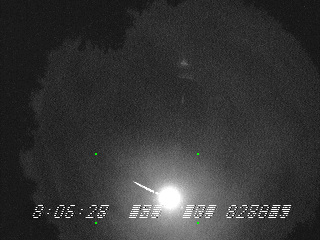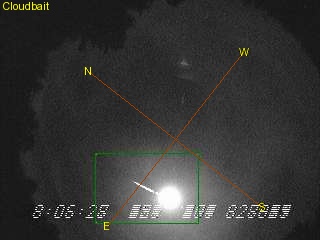[/caption]Last night, the Colorado skies played host to a dazzling fireball event. The meteor blasted through the atmosphere, detonated and outshone the Moon by 100 times. It is therefore expected that there were many eyewitnesses, and the Cloudbait Observatory (5 km north of the town of Guffey, CO) is appealing to people to report their accounts of the fireball. Fortunately, the observatory managed to capture an all-sky camera video of the early morning explosion.
The Colorado fireball comes shortly after a similar event over Canada on November 20th, where over two dozen meteorite fragments have been recovered from agricultural land. We wait in anticipation to see if this huge Colorado fireball produced any similar fragments, but eyewitness accounts will be critical to aid such a search…
In the early hours of this morning, a large explosion dominated the Colorado skies. It was yet another large meteor ploughing through the atmosphere, ending its journey in an energetic detonation. Fortunately this event didn’t suffer from the same affliction the Sudan 2008 TC3 meteoroid impact back on October 7th (i.e. lack of observers), and put on a show much like last month’s Saskatchewan fireball (and the October Ontario meteor). All in all, North America is having a great meteor season with no lack of observers, eye witnesses and all-sky cameras.
Discussing last night’s Colorado fireball, astronomer Chris Peterson describes the event: “In seven years of operation, this is the brightest fireball I’ve ever recorded. I estimate the terminal explosion at magnitude -18, more than 100 times brighter than a full Moon.”

Although the all-sky camera caught the fireball in the act, more information is needed about its location and altitude. There is every possibility that this fireball produced fragments that landed on the surface (much like last month’s Canadian fireball). For meteorite hunters to find these pieces, eye-witnesses need to contact the Cloudbait Observatory to file their reports.
Additional details of the event (from Cloudbait):
* Camera name: Cloudbait (map)
* Camera description: Cloudbait Observatory
* Camera coordinates: N38.786111 W105.483611
* Camera altitude: 2768 meters
* Total events for this site: 15906
* Event time: 2008-12-06 01:06:28 MST
* Image coordinates: (0.407,0.251) – (0.516,0.179)
* Azimuth: 79.8 – 117.9
* Altitude: ???
* Approximate duration: 1.0 seconds (28 video frames)
* Fireball: Yes
Source: Space Weather


@Maxwell:- It could be an angry swarm of intrplanetary meteoroids…
Actually, I was just thinking along similar lines. If they are able to find bits of the Colorado meteor and compare them with the bits found from November’s fireball over Canada, I wonder if scientists can deduce whether they used to be part of a larger parent body in the past…?
I suspect, though, the frequency isn’t any higher than normal, we’re just getting really good at spotting these events (probably with a huge dash of luck that the fireballs happen over populated regions with plenty of all-sky cams).
Cheers, Ian 🙂
This is odd. Another amazingly bright fireball! I saw a meteor/fireball just a few nights ago – I thought it was the lights from a car pulling in the driveway – until I turned around and caught some of a bright flash in the sky. Must be a group of meteoroids coming .
duck!
….Is it just me, or are there alot more rocks falling from the sky than one normally hears about?
Do these things travel in groups or something?
these happen a few times a year were really noticeing them more because
1. we have been monitoring the skies more and 2. they arent happening over the ocean.
Still what is the probability that we will have a very bright meteorite within a time span of a couple of months in very close location???.. I would think it will be very small…So these incidents are very intriguing!!!
It was probably a tool bag, and the bright flash was from an exploding grease gun.
where is the next place?
Two large meteorites in 2 weeks is almost certainly just a coincidence. Consider how far the Earth has traveled through space in that time. Our annual meteor showers only last a few hours before Earth has completely passed through the path of the shower, so the odds of the two objects 14 days apart being related is very small indeed (not impossible, but very unlikely).
It’s also true that these brighter, larger objects do hit our atmosphere quite often. There is no doubt we don’t see them all, those that fall during the daytime will be less noticeable and there are still vast tracts of ocean and sparsely inhabited lands where some will fall unnoticed.
(Case in point: Wasn’t there one recently we found while it was still in space and we still can’t find anyone who witnessed it hitting the atmosphere?)
So, frankly, there is nothing intriguing about two falling so close together any more so than if we didn’t see another one for a couple of years. Random chance is all you need to explain it.
Klaatu Barada Nikto!
I’m trying to determine the exact time of the fireball mentioned in this article. I happened to view what appears to be a separate incident at 8:52 PM Mountain Time this evening (Dec 6, 2008). I saw a bright fireball from the Westside of El Paso TX. It was falling also vertically over the Franklin Mountains – therefore it was traveling almost due east. I was driving and happened to see it out my driver’s window, so I was unable to watch it in its entirety – or to judge its brightness (although it was quite apparently brighter than Venus). I clearly saw considerable debris falling off and trailing behind the fireball. What is going on with all of these large debris?
Somebody should find a piece of the Colorado fireball and compare its composition to that of the Buzzard Coulee meteorite.
Wow. I don’t want to sound ignorant but will this get more frequent AND is there some sort of cover up going on? 😀 Remember the movie Armagedon? 😀
Hi there. You are not alone! We saw 3 fireballs last night 6 Dec 08 here in S.E. England UK, between 20:15 & 20:30hrs.
They followed one another at approx 3 minute intervals heading due south disappearing into the night sky. Fascinating!
Can some of this be debris from the multi-national space flights and the space station?
Does hearing count? I’m living in Aspen CO right now, and heard what sounded like 2 pistol shots. I live in a very quiet community, so I thought that was odd, but now I realize I HEARD this thing explode. Amazing!
[…] Anoche, 6 de diciembre de 2008 a las 0806:28 UT un meteoro de brillo espectacular iluminó el cielo de Colorado, Estados Unidos. El astrónomo Chris Peterson fotografió el acontecimiento […] Vía Ian O’Neill para Universe Today, y Space Weather.
We are in Bend, OR (central Oregon). I saw a fireball yesterday evening 06 December, 2008, about 2000 hrs. local Pacific standard time. I was looking East and the meteor was traveling from the North. It was initially at about 25 degrees elevation and dropped to about 10 degrees before disappearing behind trees in about four seconds. It was dropping pieces, had a reddish brown nimbus followed by smoke trailing behind it. The brightness was between that of Jupiter and Venus.
Because of its shape (irregular teardrop) I at first thought it was an aircraft falling from the sky after a mid-air collision. Could it also be the one seen from Texas? It could have been traveling Southeast.
The brightest I’ve seen in 65 years. Amazing!
it is been said”and the night shall come day and its brilliance shal outshine the sun and the lifeless planed shall continue in its journey unconcerned.
Guys bearing in mind these events have been roughly a month apart that would put these meteorites roughly 15 Million miles apart and your calling that a cluster????
When more eyes are looking, your bound to see more of anything.
I saw a really bright fireball a few years ago. It was bright blue and whistled. At first I thought it was a firework, until I saw the light reflecting off of clouds.
Just after it dimmed, I heard a distance pop.
I also saw one on Dec 07 of this year. It was really just a regular meteor, but it fell right through Orion. That also happened to be my birthday, which was nice.
That’s quite bright. One wonders what the power output across the EM spectrum integrates to, and what the explosion process is. Nuclear aside, explosions are either a very fast burning, or the result of an initial shock wave that propagates through a solid or liquid energetic material. I think meteorites don’t burn, and they are probably not made of explosives. I can understand a breakup under turbulent stress, but what is the source of the large visible flash? The assumption is the conversion of kinetic energy to heat, which would account for an infrared signature. I wonder if anyone has done detailed simulations of this process using realistic material models and heating inputs.
Good question Bill. Maybe presure change has something to do with its explosivness.